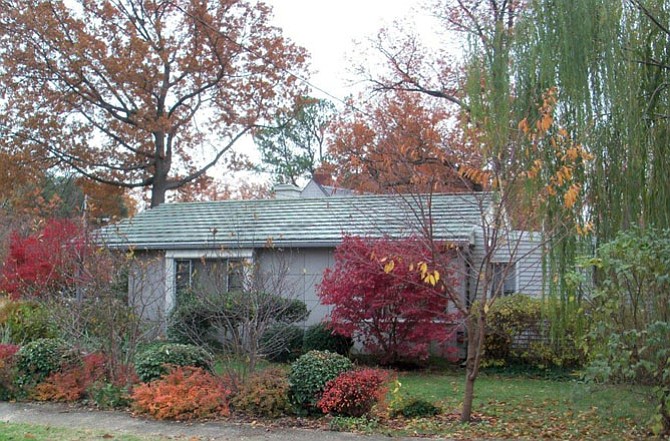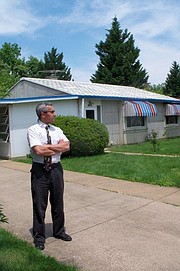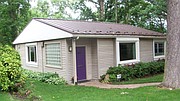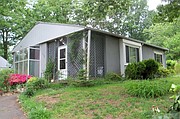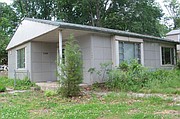2104 Scroggins Road, Alexandria Photo by Michael McMorrow.
A special sadness arises when noticing a family consists only of aging members without child or grandchild or niece or nephew, their string of genealogy reaching its end. Some people, often called “preservationists,” suffer the same sense of sadness seeing a special structure threatened. Very soon, the few remaining Lustron houses in Northern Virginia will suffer losses. They, too, are approaching their end.
With next to no home construction throughout the Great Depression and years of World War II, the United States faced a housing shortage once the war ended. One entrepreneur set about making prefabricated residences of porcelain enameled steel. The Lustron Corporation factory was located at Columbus, Ohio, in large spaces where warplanes had been constructed. A total of 2,680 houses would be built in the span of three years from 1948 to 1950, when the company filed in bankruptcy.
One-story, ranch-style homes on a slab featured open floor plans and built-in cabinetry and appliances, including the then most uncommon dishwasher. Virtually maintenance-free, materials resisted fire, termites and other vermin. The buyer had choices of six interior colors, one- and two-bedroom models and optional garages. Everything fit into less than 1,200 square feet. With government guaranteed mortgages for returning veterans, hopes were high at the start. Soon, obstacles arose. A decentralized housing industry resisted factory-produced units. Local building codes had no provision for metal houses. Builders faced working with unfamiliar, new materials. Fiscal conservatives questioned tens of millions of federal subsidies flowing to such a unique scheme. Yet, Lustron represents the only successful widespread use of porcelain enameled steel for single-family homes. As such it has become an architectural icon. The National Trust for Historic Preservation maintains records on all known houses through a website at www.lustronpreservation.org.
WITH HISTORY in mind, Arlington County had accepted, dismantled and stored a Lustron house in 2006. Warehousing costs generated irritation until a New York City museum asked for loan of the house to be featured in an exhibition. The county agreed and Arlington became known as a preservationist benefactor.
However, the return of the house meant the return of the storage costs issue. A solution appeared in an overture from the Ohio Historical Society (since renamed Ohio History Connection) to take and rebuild the house at its new museum in Columbus. Arlington assented and the house remains on permanent public display; it may be viewed online at https://ohiohistory.org.
ACROSS NORTHERN Virginia, some Lustron houses were erected in clusters; one group of 60 sprouted on Marine Corps Base Quantico but most outlived usefulness and were demolished in 2006-2007. Others were scattered solo or in twos-and-threes; Arlington originally hosted 11 and only three appeared in Alexandria.
One of Arlington’s Lustron houses currently facing destruction sits at 2915 7th Street, South. Owned by local Realtor Steve Vekony, his plan was to build a new house for his family on the site. Learning about Lustron, he toyed with incorporating it into the design of his new home, but nothing worked. The recent role for the structure has been “airbnb” short-term rental for tourists.
Due to a wave of attention from the likes of the Arlington Preservation Society, Vekony admits demolition gives him a slight case of “the guilts.” So much so, he made known a willingness to consider sale for removal or even donation to an established historic organization; the condition in both instances was removal to fit his demolition schedule. No serious proposal resulted. At this writing, spray-paint lines mark the ground and yellow tape warns of a pit where utilities have been cut and capped.
Of all owners, only Vekony offered a few personal aspects of living in a metal house. His father, a painting professional, observed that working on a Lustron was like “being inside a battleship.” Vekony himself thought it amusing to find that indoor television antennae did not work. One memory, from more than one owner, concerned the heating unit; Lustron’s was installed in the ceiling, which led to the comment “Your brow sweated while your ankles froze.”
The other Arlington unit facing imminent destruction is the derelict at 1124 South Frederick St.
Vivian Vivian Johnson occupies 1117 South Forest Drive, Arlington. Her home has undergone major reconstruction prompted by storm-felled trees during Hurricane Sandy in 2012. A resident for more than 40 years, Johnson judges her home of 1,000-plus square feet to be “a fine house” and one with exemplary “efficiency.” Across the street at number 1112, the exterior suggests very little change over the years.
TWO of the three Lustron houses in Alexandria are gone. Their replacements are seen at 2801 Davis Ave. and at 2500 Central Ave., with faint outlines of exterior paneling on the latter suggesting major new construction covered portions of the original Lustron. The third Alexandria Lustron, however, qualifies as a work of art located at 2104 Scroggins Road. Kun “Kate” Mullan and her young son took up residence more than 35 years ago, not long after her husband died. The unchanged house looks as if built yesterday, but much more pleases the eye. Mullan’s education focused on horticulture. She has blended trees, shrubs and other plantings into a setting that holds the house like a jewel. Planning Guides published by the company had emphasized landscaping, and Mullan clearly has taken the message to heart. As to living in a metal house, she remains attracted by the “modern look of a Lustron house” and by “the low demands for maintenance and repairs.”
More Information
A decade ago, Cynthia Liccese-Torres and Kim A. O’Connell prepared the booklet entitled “The Illustrious Lustron: A Guide for the Disassembly and Preservation of America’s Modern Metal Marvel.” In words and pictures, this history of Lustron Corporation focuses on dwellings in Arlington and elsewhere in Northern Virginia. A copy reposes in Arlington’s Center for Local History, Central Library, 1015 N. Quincy St.
Architectural plans for two Lustron models are found in Alexandria’s Local History/Special Collections, Kate Waller Barrett Branch Library, 717 Queen St. They are filed under “Office Flats Files – Blueprint” and then by street address (2801 Davis Ave., and 2500 Central Ave.).
The Lustron Corporation story and histories of pre-fabricated housing appear in the National Register of Historic Places form entitled “Lustron Houses in South Dakota” at http://history.sd.gov/Preservation and the series of articles appearing as http://www.oldhouseweb.com, search “Lustron.”
